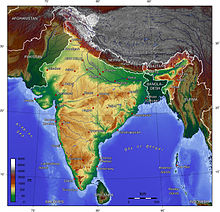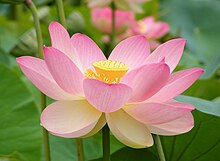Etymology
Main article: Names of India
The name India is from Indus, which is derived from the Old Persian word Hindu, from Sanskrit सिन्धु Sindhu, the historic local appellation for the Indus River.[16] The ancient Greeks referred to the Indians as Indoi (Ινδοί), the people of the Indus.[17] The Constitution of India and common usage in various Indian languages also recognise Bharat (pronounced [ˈbʱaːrət̪] ( listen)) as an official name of equal status.[18]The name Bharat is derived from the name of the legendary king Bharata in Hindu scriptures. Hindustan ([ɦɪnd̪ʊˈst̪aːn] (
listen)) as an official name of equal status.[18]The name Bharat is derived from the name of the legendary king Bharata in Hindu scriptures. Hindustan ([ɦɪnd̪ʊˈst̪aːn] ( listen)), originally a Persian word for “Land of the Hindus” referring to northern India and Pakistan before 1947, is also occasionally used as a synonym for all of India.[19]
listen)), originally a Persian word for “Land of the Hindus” referring to northern India and Pakistan before 1947, is also occasionally used as a synonym for all of India.[19]
History
| The neutrality of this section is disputed. Please see the discussion on the talk page. Please do not remove this message until the dispute is resolved. (February 2011) |
Main articles: History of India and History of the Republic of India
The Bhimbetka rock shelters in Madhya Pradesh are the earliest known traces of human life in India. In 2011, an analysis of excavations from sites in Attirampakkam, Tamil Nadu showed the presence of Acheulean hominins in the early pleistocene.[20] The first known permanent settlements appeared about 8,500 years ago and gradually developed into the Indus Valley Civilisation,[21] dating back to 3400 BCE in western India. It was followed by the Vedic period, which laid the foundations of Hinduism and other cultural aspects of early Indian society, and ended in the 500s BCE. From around 550 BCE, independent kingdoms and republics known as the Mahajanapadaswere established across the country.[22]
In the third century BCE, the Maurya Empire gradually united the Indian sub-continent underChandragupta Maurya, his son Bindusara and grandson Ashoka the Great.[23] From the third century CE, the Gupta dynasty oversaw the period referred to as ancient "India's Golden Age".[24] Empires in southern India included those of the Chalukyas, the Cholas and theVijayanagara Empire. Art, language, literature, and religion flourished under the patronage of these kings.
Following invasions from Central Asia between the 10th and 12th centuries, much of northern India came under the rule of the Delhi Sultanate and later the Mughal Empire. Under the rule ofAkbar the Great, India enjoyed much cultural and economic progress as well as religious harmony.[25][26] Mughal emperors gradually expanded their empires to cover large parts of the subcontinent. However, in northeastern India, the dominant power was the Ahom kingdom ofAssam, among the few kingdoms to have resisted Mughal subjugation. Due to Mughal persecution, the Sikhs developed a martial tradition and established the Sikh Empire which stood until the Anglo-Sikh wars in the mid-19th century.[27] The first major threat to Mughal imperial power came from a Hindu Rajput king Maha Rana Pratap of Mewar in the 16th century and later from a Hindu state known as the Maratha confederacy, that ruled much of India in the mid-18th century.[28]
From the 16th century, European powers such as Portugal, the Netherlands, France, and Great Britain established trading posts and later took advantage of internal conflicts to establish colonies. By 1856, most of India had come under the control of the British East India Company.[29] A year later, a nationwide insurrection of rebelling military units and kingdoms, known as India's First War of Independence or the Sepoy Mutiny, seriously challenged the Company's control but eventually failed. As a result of the instability, India was brought under the direct rule of the British Crown.
In the 20th century, the Indian independence movement was launched by the Indian National Congress and other political organisations.[30] A large part of the movement for independence was led by Mahatma Gandhi and the Indian National Congress, which led millions of people in several national campaigns of non-violent civil disobedience.[31]
On 15 August 1947, India gained independence from British rule, but at the same time the Muslim-majority areas were partitioned to form a separate state of Pakistan.[32] On 26 January 1950, India became a republic and a new constitution came into effect.[33]
Since independence, India has faced challenges from religious violence, casteism, naxalism, terrorism and regional separatist insurgencies, especially in Jammu and Kashmir and Northeast India. Since the 1990s terrorist attacks have affected many Indian cities. India has unresolved territorial disputes with the People's Republic of China, which, in 1962, escalated into the Sino-Indian War, and with Pakistan, which resulted in wars in 1947, 1965, 1971 and 1999. India is a founding member of the United Nations (as British India) and the Non-Aligned Movement.
India is a state armed with nuclear weapons; having conducted its first nuclear test in 1974,[34] followed by another five tests in 1998.[34]Beginning 1991, significant economic reforms[35] have transformed India into one of the fastest-growing economies in the world, increasing its global clout.[36]
Geography
Main article: Geography of India
See also: Geology of India
India, the major portion of the Indian subcontinent, lies atop the Indian tectonic plate, a minor plate within the Indo-Australian Plate.[37] India's defining geological processes commenced seventy-five million years ago, when the Indian subcontinent, then part of the southern supercontinent Gondwana, began a northeastwards drift—lasting fifty million years—across the then unformed Indian Ocean.[37] The subcontinent's subsequent collision with the Eurasian Plate and subduction under it, gave rise to the Himalayas, the planet's highest mountains, which now abut India in the north and the northeast.[37] In the former seabed immediately south of the emerging Himalayas, plate movement created a vast trough, which, having gradually been filled with river-borne sediment,[38] now forms the Indo-Gangetic Plain.[39] To the west of this plain, and cut off from it by the Aravalli Range, lies the Thar Desert.[40]
The original Indian plate now survives as peninsular India, the oldest and geologically most stable part of India, and extends as far north as theSatpura and Vindhya ranges in central India. These parallel ranges run from the Arabian Sea coast in Gujarat in the west to the coal-rich Chota Nagpur Plateau in Jharkhand in the east. To their south, the remaining peninsular landmass, the Deccan Plateau, is flanked on the left and right by the coastal ranges, Western Ghats and Eastern Ghats respectively;[41] the plateau contains the oldest rock formations in India, some over one billion years old. Constituted in such fashion, India lies to the north of the equator between 6°44' and 35°30' north latitude[42] and 68°7' and 97°25' east longitude.[43]
India's coast is 7,517 kilometres (4,700 mi) long; of this distance, 5,423 kilometres (3,400 mi) belong to peninsular India, and 2,094 kilometres (1,300 mi) to the Andaman, Nicobar, and Lakshadweep Islands.[44] Major Himalayan-origin rivers that substantially flow through India include the Ganges (Ganga) and the Brahmaputra, both of which drain into the Bay of Bengal. Important tributaries of the Ganges include the Yamuna and the Kosi; the latter's extremely low gradient causes disastrous floods every year. Major peninsular rivers, whose steeper gradients prevent their waters from flooding, include the Godavari, the Mahanadi, the Kaveri, and theKrishna, which also drain into the Bay of Bengal; and the Narmada and the Tapti, which drain into the Arabian Sea. Among notable coastal features of India are the marshy Rann of Kutch in western India, and the alluvial Sundarbans delta, which India shares with Bangladesh. India has two archipelagos: the Lakshadweep, coral atolls off India's south-western coast; and the Andaman and Nicobar Islands, a volcanic chain in the Andaman Sea.[45]
Climate
Main article: Climate of India
India's climate is strongly influenced by the Himalayas and the Thar Desert, both of which drive the monsoons.[46] The Himalayas prevent cold Central Asian katabatic winds from blowing in, keeping the bulk of the Indian subcontinent warmer than most locations at similar latitudes.[47][48] Four major climatic groupings predominate: tropical wet, tropical dry, subtropical humid, and montane.[49]
Biodiversity
Main article: Wildlife of India
See also: List of ecoregions in India
Lying within the Indomalaya ecozone, with three hotspots located within its area, India displays significant biodiversity.[52] As one of the seventeen megadiverse countries, it is home to 7.6 percent of all mammalian, 12.6 percent of all avian, 6.2 percent of all reptilian, 4.4 percent of all amphibian, 11.7 percent of all fish, and 6.0 percent of all flowering plant species.[53] Many ecoregions, such as the shola forests, exhibit extremely high rates of endemism; overall, 33 percent of plant species are endemic.[54][55]
Forest cover ranges from the tropical rainforest of the Andaman Islands, Western Ghats, and the northeast to the temperate coniferous forestof the Himalayas. Between these extremes lie the sal-dominated moist deciduous forest of the east; the teak-dominated dry deciduous forest of the centre and south; and the babul-dominated thorn forest of the central Deccan and western Gangetic plain.[56] Important trees include the medicinal neem, widely used in rural herbal remedies. The pipal fig tree, shown on the seals of Mohenjo-daro, shaded Gautama Buddha as he so





